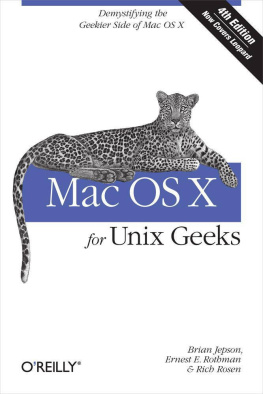Chuck Toporek - Mac OS X Leopard Pocket Guide
Here you can read online Chuck Toporek - Mac OS X Leopard Pocket Guide full text of the book (entire story) in english for free. Download pdf and epub, get meaning, cover and reviews about this ebook. year: 2009, publisher: OReilly Media, genre: Home and family. Description of the work, (preface) as well as reviews are available. Best literature library LitArk.com created for fans of good reading and offers a wide selection of genres:
Romance novel
Science fiction
Adventure
Detective
Science
History
Home and family
Prose
Art
Politics
Computer
Non-fiction
Religion
Business
Children
Humor
Choose a favorite category and find really read worthwhile books. Enjoy immersion in the world of imagination, feel the emotions of the characters or learn something new for yourself, make an fascinating discovery.
- Book:Mac OS X Leopard Pocket Guide
- Author:
- Publisher:OReilly Media
- Genre:
- Year:2009
- Rating:5 / 5
- Favourites:Add to favourites
- Your mark:
Mac OS X Leopard Pocket Guide: summary, description and annotation
We offer to read an annotation, description, summary or preface (depends on what the author of the book "Mac OS X Leopard Pocket Guide" wrote himself). If you haven't found the necessary information about the book — write in the comments, we will try to find it.
No matter how much Mac experience you have, Mac OS X Leopard requires that you get reacquainted. This little guide is packed with more than 300 tips and techniques to help you do just that. You get all details you need to learn Leopards new features, configure your system, and get the most out of your Mac. Pronto.
Mac OS X Leopard Pocket Guide offers an easy-to-read format for users of all levels. If youre a Mac newcomer, theres a Survival Guide that explains how to adapt, and a chapter on Mac OS Xs key features. Experienced Mac users can go right to the heart of Leopard with chapters on system preferences, applications and utilities, and configuring. In all, plenty of tables, concise descriptions, and step-by-step instructions explain:
- Whats new in Leopard, including the Time Machine
- How to use Leopards totally revamped Finder
- All about Spaces and how to quickly flip between them
- How to search for and find things with Spotlight
- How to use...
Chuck Toporek: author's other books
Who wrote Mac OS X Leopard Pocket Guide? Find out the surname, the name of the author of the book and a list of all author's works by series.












 -O.
-O.